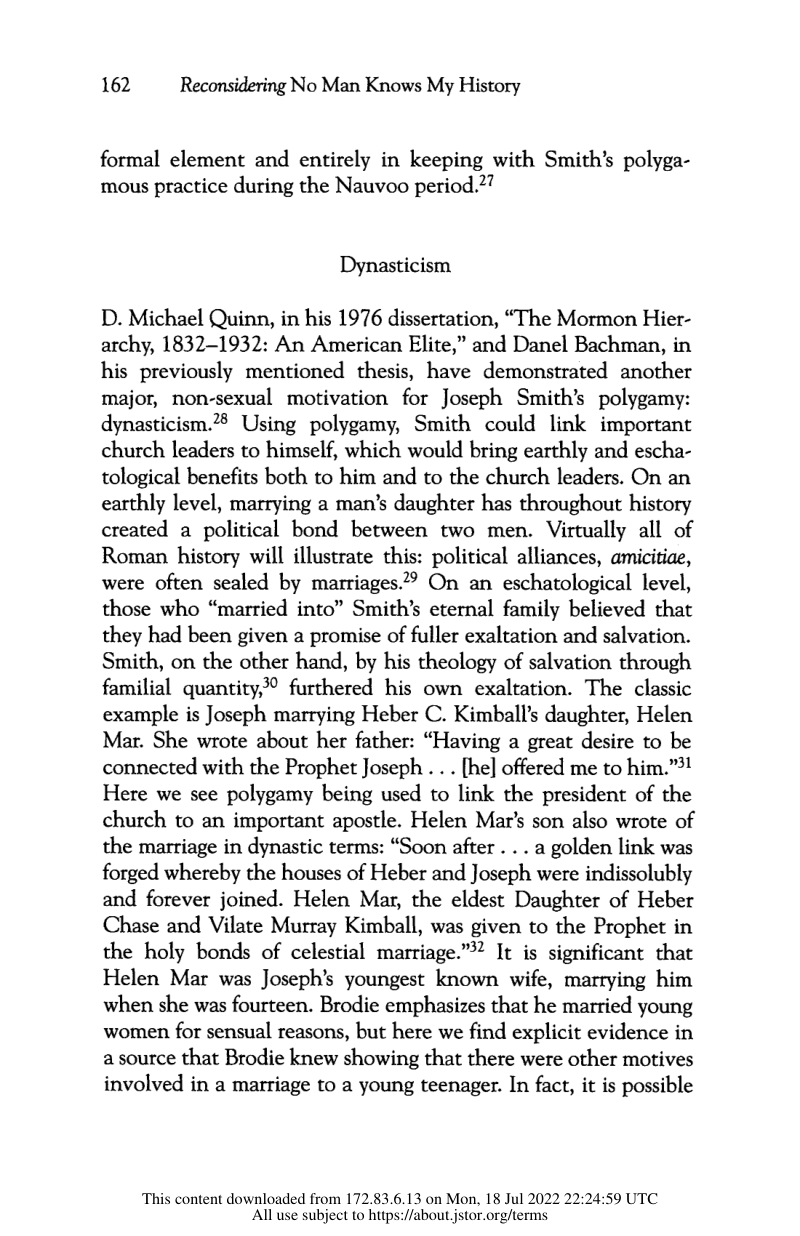Todd Compton reviews Brodie's work on plural marriage; discusses advances made in scholarship on Joseph's polygamy.
- Type
- Academic / Technical Report
- Source
- Todd M. Compton LDSDisaffected
- Hearsay
- DirectSecondary
- Reference
Todd Compton, "Fawn Brodie on Joseph Smith's Plural Wives and Polygamy: A Critical View," in Reconsidering No Man Knows My History: Fawn B. Brodie and Joseph Smith in Retrospect, ed. Newell G. Bringhurst (Logan, UT: Utah State University Press, 1996), 154–194
- Scribe/Publisher
- Utah State University
- People
- Todd M. Compton
- Audience
- Reading Public
- Transcription
The classic example is Joseph marrying Heber C. Kimball's daughter, Helen Mar. She wrote about her father: "Having a great desire to be connected with the Prophet Joseph ... [he] offered me to him." Here we see polygamy being used to link the president of the church to an important apostle. Helen Mar's son also wrote of the marriage in dynastic terms: "Soon after ... a golden link was forged whereby the houses of Heber and Joseph were indissolubly and forever joined. Helen Mar, the eldest Daughter of Heber Chase and Vilate Murray Kimball, was given to the Prophet in the holy bonds of celestial marriage." It is significant that Helen Mar was Joseph's youngest known wife, marrying him when she was fourteen. Brodie emphasizes that he married young women for sensual reasons, but here we find explicit evidence in a source that Brodie knew showing that there were other motives involved in a marriage to a young teenager. In fact, it is possible that Joseph Smith never had sexual relations with Helen Mar; there is no unambiguous documentation, positive or negative, on the issue.
Other marriages that show dynastic elements are the marriages of Joseph to Sarah Ann Whitney (linking Joseph to Bishop Newell Whitney); to Zina and Presendia Huntington (linking him to his close friend Dimick Huntington, as well as to High Councillor William Huntington, their father); to Fanny Young (linking him with Brigham Young, her brother, an apostle); to Rhoda Richards (linking him with Willard Richards, her brother, an apostle); and to Melissa Lott (linking him with loyalist Cornelius Lott).
It is possible that even Smith's polyandry, his marriage to women already married (of which there are eleven instances among the "certain" wives), had dynastic overtones. The fact that some men, after Joseph Smith's death, knowingly gave their wives to him for eternity in the Nauvoo temple suggests this, as does a passage from the anti~Mormon poem published during Joseph's life, "Buckeye's Lamentation for Want of More Wives," which hints that some men would receive greater salvation by giving their wives to the prophet.34 The writings of Henry Jacobs, the "first husband" in the best~documented polyandrous triangle, show that he felt a great reverence for Joseph Smith even though he knew that his wife would be married to Joseph in eternity; this would fit comfortably within the dynastic model for explaining some polygamous marriages.
. . .
Sexuality was undoubtedly an element in Joseph Smith's plural marriages, and Brodie was correct in seeing it as an important motivating factor in his polygamy. However, to view it as the only, or by far the most important, motivating force in his theory and practice of polygamy, as she does, resulted in an unbalanced picture of Joseph Smith and his religiosity. Joseph Smith's burnt–over district biblical primitivism and his desire to arrange earthly and heavenly dynastic linkings with other Latter–day Saint leaders must also be considered.
. . .
On the other hand, there is some reliable evidence that Joseph Smith's polygamous marriages did produce children. There is an affidavit by Josephine Lyon Fisher, a child of Sylvia Sessions Lyon Smith Kimball Clark, one of Joseph's polyandrous wives, which asserts that Sylvia, on her deathbed, told her that she, Josephine, was the biological child of Joseph Smith. Although it is safest to assume that the children of Joseph Smith's polyandrous wives were not his, barring strong evidence to the contrary, such an affidavit as this qualifies as strong evidence to the contrary.
- Citations in Mormonr Qnas
The B. H. Roberts Foundation is not owned by, operated by, or affiliated with the Church of Jesus Christ of Latter-day Saints.

